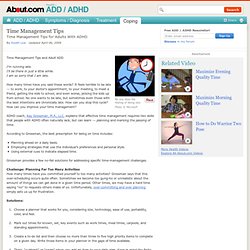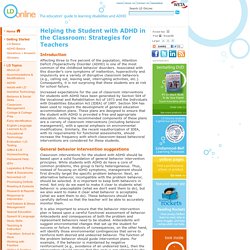

ADD versus ADHD What's the difference? Description Of ADD vs.

ADHD By Barbara C Fisher & Ross A Beckley Definition: AD/HD is the presence of a genetic biochemical disorder that does not allow people to work to their full potential. The Brain: a) Frontal Lobe integrates all the information b) Parietal area processes sensory information c) Temporal – memory, balance, and hearing d) Occipital is the visual area Only the Frontal and Parietal areas are involved in AD/HD.
Neurotransmitters: The brain talks to itself chemically and electronically. A chemical imbalance is a neurotransmitter failure. Symptoms can vary from day to day, hour to hour and sometimes cannot be seen. ADD Without Hyperactivity is not always recognizable if the person can compensate and "get by". ADD Without Hyperactivity - Over-focused Subtype Indications: 1. Time Management Tips - Time Management Tips for ADHD. Time Management Tips and Adult ADD I’m running late.

I’ll be there in just a little while. I am so sorry that I am late. How many times have you said these words? It feels terrible to be late -– to work, to your doctor's appointment, to your meeting, to meet a friend, getting the kids to school, and even worse, picking the kids up from school. ADHD coach, Kay Grossman, M.A., LLC, explains that effective time management requires two skills that people with ADHD often naturally lack, but can learn -– planning and marking the passing of time. According to Grossman, the best prescription for being on time includes: Planning ahead on a daily basis. Grossman provides a few no-fail solutions for addressing specific time-management challenges. Challenge: Planning Far Too Many Activities How many times have you committed yourself to too many activities? Write Your Own Behavior Plan.
A good Behavior Intervention Plan (BIP) can make a big difference in how a student with special needs acts and reacts in a school setting.

However, getting the appropriate school personnel to do the necessary behavior analysis and put a plan together can be a frustratingly lengthy process. You may want to propose a behavior plan of your own -- particularly if you have a good relationship with your child study team, and your child's teachers are as frustrated by the delays as you are. When I wrote a behavior plan for my son, he was in the fourth grade and having significant behavior struggles. The school called in a behaviorist ... but her schedule was so packed she wouldn't be able to come for months. Frustrated, I typed up an overview of the behavioral issues associated with his disability, the things I knew worked for my guy, and links to websites with tips from other school districts as to how to handle kids like him. Sample Plans for Specific Disabilities Blank Forms. Teach Effectively! Teaching Children with Attention Deficit Hyperactivity Disorder: Instructional Strategies and Practices.
By: U.S.

Department of Education, Office of Special Education Programs (2004) Introduction Inattention, hyperactivity, and impulsivity are the core symptoms of Attention Deficit Hyperactivity Disorder (ADHD). A child's academic success is often dependent on his or her ability to attend to tasks and teacher and classroom expectations with minimal distraction. Such skill enables a student to acquire necessary information, complete assignments, and participate in classroom activities and discussions (Forness & Kavale, 2001). Identifying children with ADHD There are an estimated 1.46 to 2.46 million children with ADHD in the United States ; together these children constitute 3–5 percent of the student population (Stevens, 1997; American Psychiatric Association, 1994). The behaviors associated with ADHD change as children grow older. Although many children have only ADHD, others have additional academic or behavioral diagnoses.
Evaluate the child's individual needs and strengths. Dyslexia/ADHD Online. Reading Recovery. Reading Recovery has a strong tradition of success with the lowest-achieving children.

Developed in New Zealand, Reading Recovery now also operates in all states in Australia, the United States, Canada and the United Kingdom. The goal of Reading Recovery is to reduce the number of Year 1 students having difficulties learning to read and write. Students receive a series of individual, 30-minute Reading Recovery lessons daily from a specially trained teacher. This section explains: how the program is implementedhow schools can participatehow teachers and tutors can receive trainingthe outcomes of the 2006 programprovides links to further reading and useful resources online.
Implementation of Reading RecoveryReading Recovery operates at several levels of the education system, as students, teachers and schools work together to reduce reading and writing problems. ADHD management Podcast. ADHD,ADD, Attention Deficit Hyperactivity Disorder. Helping the Student with ADHD in the Classroom: Strategies for Teachers. Introduction Affecting three to five percent of the population, Attention Deficit /Hyperactivity Disorder (ADHD) is one of the most common of the childhood behavior disorders.

Associated with this disorder's core symptoms of inattention, hyperactivity and impulsivity are a variety of disruptive classroom behaviors (e.g., calling out, leaving seat, interrupting activities, etc.). Consequently, it is not surprising that these students are at risk for school failure. Increased expectations for the use of classroom interventions for students with ADHD have been generated by Section 504 of the Vocational and Rehabilitation Act of 1973 and the Individuals with Disabilities Education Act (IDEA) of 1997.
Section 504 has been used to require the development of general education accommodation plans. LD OnLine: learning disabilities and ADHD. ADHD.